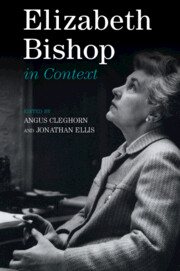Book contents
- Elizabeth Bishop in Context
- Elizabeth Bishop in Context
- Copyright page
- Contents
- Figure
- Contributors
- Acknowledgements
- Note on Referencing and Abbreviations
- Chronology
- Introduction
- Part I Places
- Part II Forms
- Part III Literary Contexts
- Part IV Politics, Society and Culture
- Chapter 18 War
- Chapter 19 The Cold War
- Chapter 20 Music
- Chapter 21 Psychoanalysis
- Chapter 22 Religion
- Chapter 23 Anthropology
- Chapter 24 Travel
- Part V Identity
- Part VI Reception and Criticism
- Works Cited
- Index
Chapter 20 - Music
from Part IV - Politics, Society and Culture
Published online by Cambridge University Press: 06 August 2021
- Elizabeth Bishop in Context
- Elizabeth Bishop in Context
- Copyright page
- Contents
- Figure
- Contributors
- Acknowledgements
- Note on Referencing and Abbreviations
- Chronology
- Introduction
- Part I Places
- Part II Forms
- Part III Literary Contexts
- Part IV Politics, Society and Culture
- Chapter 18 War
- Chapter 19 The Cold War
- Chapter 20 Music
- Chapter 21 Psychoanalysis
- Chapter 22 Religion
- Chapter 23 Anthropology
- Chapter 24 Travel
- Part V Identity
- Part VI Reception and Criticism
- Works Cited
- Index
Summary
Music, for too long, has been omitted in evaluations of Elizabeth Bishop – who studied piano and counterpoint for years and contemplated becoming a composer; who crossed continents with a clavichord, collecting instruments, scores, and records; and who cherished music as a profound analogue for poetry and its closest cousin among the arts. While generations of critics have given us frames for understanding Bishop as a visualist, this chapter shifts focus from her seeing to her hearing and enumerates five distinguishing characteristics of music as it appears in her work: manipulation of time, markings of place, involvement of both nature and culture, emotionally driven fantasy, and thisworldly sources. Following Bishop’s listening chronologically, as she encounters the European classical tradition, African American and Caribbean popular musics, and Brazilian folk music and samba, this chapter argues that Bishop fruitfully counterpointed music with her shifting sense of lyric poetry: sometimes music and lyrics bordered lyric; sometimes song was lyric’s unachievable opposite.
- Type
- Chapter
- Information
- Elizabeth Bishop in Context , pp. 233 - 244Publisher: Cambridge University PressPrint publication year: 2021

